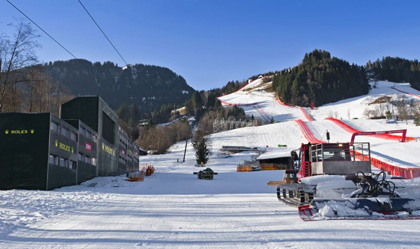
Vue of the Downhill finish area, Photo by: Rolex /Kurt Arrigo
. world ski news : Kitzbuehel looks to the stars - 18 ßíóàðè 2011 - 17:30
Hahnenkamm Races - January 21 - 23, 2011, Kitzbuehel, Austria
At this time of the year the Alpine Ski World Cup has hit the ground and is running hard. For the sport’s top skiers, the schedule is punishing, gruelling yet rewarding for those that attain their goals. The ‘marquee’ big name events are upon us. None are arguably greater than this coming weekend’s Hahnenkamm-Rennen (“Races”), held in the Tyrolean town of Kitzbühel.

Vue of the Downhill finish area, Photo by: Rolex /Kurt Arrigo
According to legend, Kitzbühel was the setting for the decision that changed the shape of competitive alpine skiing. In 1966, Honoré Bonnet and Bob Beattie, respectively the directors of the French and American ski teams, and a journalist, Serge Lang, met on the Seidlalm overlooking the Streif run. The idea for a season long series linking the alpine contest was thrown into the conversation and rapidly gained momentum, being adopted by the FIS (International Ski Federation) in the same year. The Alpine Ski World Cup was first held in 1967; the male winner…none other than Rolex Testimonee and French icon of snow sports, Jean-Claude Killy.
Off-piste
Killy became a Rolex Testimonee in 1968 following his triple medal win at the Winter Olympics in Grenoble. Killy is one in a long line of noble wearers of Rolex watches; a tradition that began in 1927 with Mercedes Gleitze, who swam the English Channel wearing a Rolex. Her swim lasted over ten hours, the watch survived intact and working perfectly. The triumph led to the concept of the Testimonee: men and women whose achievements, exploits and daring would match the qualities the watch brand. In 1967, when Killy was setting the world on fire with an all-consuming victory in the inaugural Alpine Ski World Cup, Rolex initiated its partnership with golf through Arnold Palmer, the first of the ‘Big Three’ that made golf what it is today, to associate with the brand. The other two are, of course, Jack Nicklaus and Gary Player. That concept of binding Rolex to the careers of leaders and achievers is continued today, and in the male arena of alpine skiing the baton held for so long by Killy, and more recently by Hermann Maier, has now been passed to the Swiss skier Carlo Janka who will be competing at the 71st Hahnenkamm Races this weekend.
Course Notes
Last weekend, Wengen in Switzerland was painted in red and white as the downhill racers came to town for the Lauberhorn Races. Rolex Testimonee Carlo Janka placed second in the super G and third on the podium in the downhill, suggesting a return to his true potential ahead of the Super-G on Friday and the Race, the legendary downhill on the Streif on Saturday. Together with last year’s winner Didier Cuche, the Swiss maestros are out for revenge this weekend in Kitzbühel. “(Last weekend) was a good weekend for Austria and Klaus Kroell but we hope we can challenge them in Kitzbühel,” according to Carlo Janka, who also had thoughts on his performance: “January is always tough on the Ski World Cup. It is one hit after the other and we have a very hard race next week-end.” But toughness, mental and physical, is what the Hahnenkamm Races are all about. The myth surrounding this weekend is built on this premise.
For detailed results about the 71st Hahnenkamm Races please visit: www.hahnenkamm.com/results.html
Hahnenkamm History
In 1984, at the age of 30, Austria’s Franz Klammer solidified his status as Kitzbühel’s most prolific champion when he won a record fourth Hahnenkamm Downhill title. In doing so, he surpassed fellow Austrian icon, Karl Schranz, who has three victories to his credit. Klammer won the ’84 race handily, seven years after his last victory, defeating runner-up Erwin Resch by 0.57 seconds.
Achieving at least three wins on the ‘Streif’ has been a feat that only Klammer and Schranz have managed. Switzerland’s 2008 & 2010 champion, Didier Cuche will strive to join this exclusive club come this Saturday.
Twelve racers, including six Austrians have two Hahnenkamm victories. And some of the all-time greats including Rolex Testimonees Hermann Maier and Jean-Claude Killy as well as Austria’s Patrick Ortlieb and Michael Walchhofer have managed just one victory.
By the Numbers
Three times in the history of the Hahnenkamm Downhill during the World Cup era, three skiers from the same nation have finished 1-2-3 and shared the podium. It first occurred in 1984, as Anton Steiner joined his countryman Klammer and Resch to complete the Austrian sweep.
In 1992, the Swiss duplicated this difficult accomplishment. Franz Heinzer captured his second Hahnenkamm Downhill with teammates Daniel Mahrer and Xavier Gigandet also on the podium.
Finally, in 1998, Austria once again swept the podium. This time, winner Hans Knauss was accompanied by countrymen Peter Rzehak and Werner Franz.
Quotable
“The Hahnenkamm offers the greatest variety of difficulties,” said 1967 downhill, slalom and combined champion, Jean-Claude Killy. “It permits a true technician to prove that he is the best.”
“It’s like a big roller coaster, only faster,” said American racer Spyder Sabich, in 1969.
“I never look at the net because it has a certain bad effect on skiers when they see it,” said Austria’s Karl Schranz regarding the safety netting at the bottom of the treacherous Steilhang. “Besides that, I’m always going too fast to see it. And besides I think the thing may be in the wrong place anyhow!”
HahnenkammNews.com
January 18, 2011